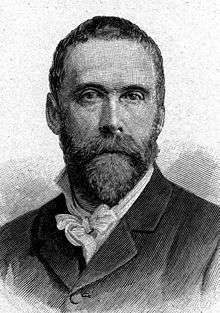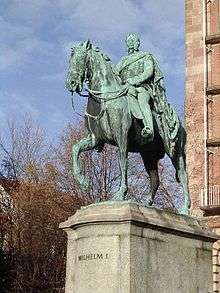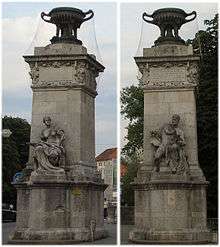Syrius Eberle
Syrius Eberle (9 December 1844 – 12 April 1903) was a German sculptor and art professor.



Biography
Eberle was born in Pfronten, Allgäu, the son of a carpenter.[1] He grew up in the Stapferhaus in Pfronten. He married the daughter of the lithographer Thomas Driendl (1805-1859), also from Pfronten.
Eberle first trained as a cabinet maker, and then studied from 1866 to 1872 at the Königliche Kunstakademie ("Royal Academy of Arts") in Munich. From 1884 he was himself a professor in the department of religious sculpture.[2] Among his students were Georg Pezold,[2] Heinrich Düll,[2] Heinrich Waderé, Johann Vierthaler, Max Heilmaier, Georg Wrba, Georg Busch, Clemens Buscher, Josef Rauch, Bruno Diamant, Josef Flossmann, August Drumm, Emil Dittler and Ignatius Taschner.
Ludwig II, King of Bavaria, gave Eberle several commissions for decorations for his newly built castles, and also for single figures, groups, panels, and almost all his carriages and sledges.
Eberle created the former war memorial in Kempten, which in his time stood on the site of the present bus station. The bronze figures were melted down during World War II.
In 1889 his design in the competition for a national monument to the Brothers Grimm won only third prize. The organisers disagreed however about the design that won first prize, by the sculptor Max Wiese, whereupon they sought the opinion of Wilhelm Grimm's son, the art and literary historian Herman Grimm of Berlin. He decided on Eberle's design, and the commission for the monument was therefore given to him. On 18 October 1896 the formal unveiling of the monument took place.[3]
During the years 1890-1892 Eberle made the four pylons for the Ludwigsbrücke ("Ludwig Bridge") in Munich, as well as the 1890 monument in the Ottostrasse to Franz Xaver Gabelsberger, the inventor of stenography.
As a professor at the Munich Kunstakademie Eberle was a member in 1893 of the commission formed to evaluate the suggestions for the new building of the Bayerisches Nationalmuseum (built 1894/95).[4]
He also won the competition of August 1897 for the equestrian statue of Kaiser Wilhelm I in Nuremberg, but died before its completion: the commission was taken over by Wilhelm von Rümann.
Eberle was a member of the Munich Albrecht-Dürer-Verein, an association of students of the Academy of Arts founded in 1885 by the sculptor Georg Busch. Here too Eberle gave evening sessions on the composition of Christian themes.[5]
Eberle retired to Bozen in the South Tyrol, where he died in 1903.
Notes and references
- Akademie der Bildenden Künste München: Syrius Eberle, 02256, zweites Matrikelbuch 1841-1884. Accessed on 2 October 2011.
- Akademie der Bildenden Künste München: Lehrer der Akademie. Eberle, Syrius. Accessed on 2 October 2011.
- Today the national monument forms the starting point of the Deutsche Märchenstrasse from Hanau to Bremen. The Japanese love of the Brothers Grimm and their fairy stories led in 1989 to the casting of a copy of the monument on a scale of 1:1 for the "Kingdom of Happiness" Kofuko, a leisure park in Obihiro on the island of Hokkaidō.
- "This commission consisted, besides members of the Landtag, of artists, architects, officials of the National Museum, an art historian, and representatives of the city. The first sitting of the commission took place on 28 January 1893 in the Ministry of Culture". – Michael Kamp: Das Museum als Ort der Politik. Münchner Museen im 19. Jahrhundert, p. 145, dissertation, Ludwig-Maximilians-Universität München, 2002
- Susanne Kähler: Fortuna für die Stadt. Zur Wiederaufstellung der Kuppelfigur auf Ludwig Hoffmanns Stadthaus
Sources
- Syrius Eberle in: Ulrich Thieme, Felix Becker et al.: Allgemeines Lexikon der Bildenden Künstler von der Antike bis zur Gegenwart. Band 10, p. 301. E. A. Seemann, Leipzig 1914
- Allgemeines Künstlerlexikon (2002), vol. 31, p. 559
External links
| Wikimedia Commons has media related to Syrius Eberle. |
- Nationaldenkmal der Brüder Grimm (in German)